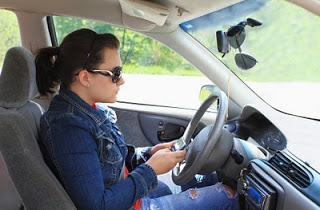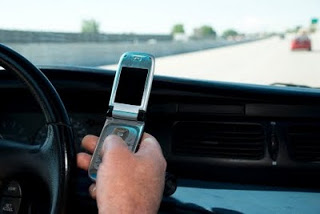Category Archive: Texting

Measures Taken to Stop Distracted Driving
May 5, 2010
Each day, as it seems, more and more information about the dangers of distracted driving comes out — which increases the awareness of drivers about the growing problem. But what has been done? What exactly are organizations and individuals doing to combat distracted driving?
Forming Organizations
When you Google “distracted driving groups” it will yield several results — of individuals banding together, increasing awareness on distracted driving, on a local or country-wide basis. These can be as simple as asking people to pledge against distracted driving, like Oprah’s No Phone Zone, or wearing thumb socks to show a driver’s support for not texting while driving. These groups establish their presence online, in various social networking services, making it easier for their targets to get the message.
Enacting Laws
With the nationwide awareness on the shocking statistics of texting while driving, local governments have acted to put in motion laws that would prohibit cell phone usage while on the road. So far, more than 30 states have a law that places a ban on texting while behind the wheel, urging drivers to think twice before they pull out their phones, unless they want a penalty. For now, the options are being weighed on how to effectively enforce texting ban laws — but public support usually wins, and a law is enacted.
Phone/Text-blocker apps
Stopping phone use while on the road? Simple. Install a phone/text-blocker app. These applications interface the phone to the car’s GPS and if it sees that the car is in motion, the app disables the phone’s features. With crash-risk increasing 4 times/talking on the phone and 23 times/texting — it may help discipline the driver into not relying on their phones so much while on the road, until hopefully, they won’t have a need for such an application anymore. Learn more about apps like this including http://www.Textecution.com/.
Mock Crashes
Several local/teen driving advocacy groups have set up mock crashes to remind teen drivers (the group who are most likely to engage in texting while driving) what could potentially happen if they text and drive at the same time. In most places, the mock crashes are set up in a way that, the first things that teens going to school are going to see are wrecked cars, teen-drivers-playing-dead-with-phone-in-hand and lots of fake blood. It is a shocking, yet accurate statement that would inform teen drivers of the potential consequences.
Trial Runs
There are also trial runs — usually hosted by a state’s DMV along with several advocates against distracted driving — they allow drivers to experience firsthand what could happen should they attempt to text while driving. Set in an enclosed space, with only traffic cones as obstacles, there are only a few who manage to get through the course without hitting any of the cones while texting/driving. There are drivers who believe they are perfectly capable of handling both tasks, but running through a trial distracted driving course more or less proves them otherwise.
Ads
Various organizations would release ads that are either funny or serious in order to make their point. Some organizations do their advertisements a step above by involving the people themselves — they create contests asking drivers if they have what it takes to get the message across, in video form. Which is a good thing — it awakens an enthusiasm and awareness in teen drivers — which makes them think about safety when driving.
Distracted Driving Courses
The addition of cell phones, texting and driving, in-vehicle video entertainment, and navigation systems lengthens the long list of driver distractions. Research reveals that many new drivers do not recognize the risk of these activities when driving. To make teen drivers more aware of the risks there are courses like Dangers of Distracted Driving. The course creates a clear understanding of the distractions while driving and how they can cause crashes and cost lives.

Coming Soon, Texting your Way to a Fine
July 24, 2007
Quite a few states have jumped on the bandwagon about banning driving while talking on the cell phone. However, the growing trend of texting while driving has caused lawmakers, especially in New York to go back to the drawing board to include texting in that ban. And after the recent fatal accident where five teens were killed, with texting as a likely culprit, the heat is really on to get the new ruling passed.
The question remains, “Will a ban on texting really help prevent accidents?” No one really knows for sure and as a result, the proposed law change is getting some mixed reviews. Some people feel that the wireless industry is not doing enough to advertise the dangers of cell phone use while driving. However, others feel that it all boils down to practicing basic defensive driving skills.
People hear that talking on the cell phone and texting has caused accidents and killed people, yet they do not hinder their own actions. Why is that? It’s just like smoking. You know that it is hazardous to your health, yet you do it anyway. The same principle applies with cell phones. Are our lives so busy and competitive that we cannot miss a single moment with our cell phones? How did we ever get along twenty or thirty years ago?
Another part of the problem is how to keep the teenagers from texting while driving. Many of them admit to doing it and know it is dangerous and still do it anyway. At some point, we have to accept responsibility for ourselves. In the case of teenagers who are still feeling their way around the whole driving thing, the parents are going to have to be the guiding force in appropriate driving behavior in teens. Of course, that means that they will have to clean up their own acts so that they can lead by example.
It is because people know better yet do it anyway that is precipitating this texting inclusion in the existing cell phone law. Sometimes, we have to help those who refuse to help themselves. And if it takes imposing fines to get the point across, so be it. The problem is that no one truly knows how much of an impact this law will make on saving lives. We’ll just have to wait and see.

Text Messaging Cause of Fatal Teen Crash
August 3, 2006
A 17-year-old likely will face misdemeanor charges after allegedly losing control of his car while text messaging and hitting a bicyclist.
The bicyclist, Jim R. Price of Highlands Ranch, died Friday, two days after the accident.
The spokesman for Douglas County Sheriff’s Office stated that the driver could face a charge of careless driving resulting in death. Under Colorado law, the teen could face up to a year in prison.
Source: USAToday.com
Safe Driving Lesson Learned
Distracted driving: According to a 2002 NHTSA/Gallup Poll, drivers often allow their attention to be diverted from their driving by one or more of the following:
- Cellular phones: About 30% of all drivers use a cell phone while driving to make outgoing or incoming calls on at least some of their driving trips. An estimated 292,000 drivers were involved in a crash attributed to cell phone use between 1997 and 2002.
- Drowsiness: 37% of the driving population says they have nodded off for at least a moment or fallen asleep while driving at some time in their life. An estimated 7.5 million drivers have fallen asleep while driving during a given month.
- Dealing with children: Nearly one in four (24%) drivers deal with children in the back seat of the car while driving.
- Eating or drinking: Half of all drivers (49%) report eating or drinking at least occasionally while driving, with 14% doing so on three-quarters or more of their driving trips.
When you drive, don’t allow poor judgment or distractions to interfere with your driving. Put safety first!
This post is an excerpt from a recent edition of the Safe Driving Teen Monthly Bulletin. Each month the National Safety Commission publishes the bulletin for teens and parents designed to improve teen driver behavior, attitude, skills, and experience. Subscription Details

